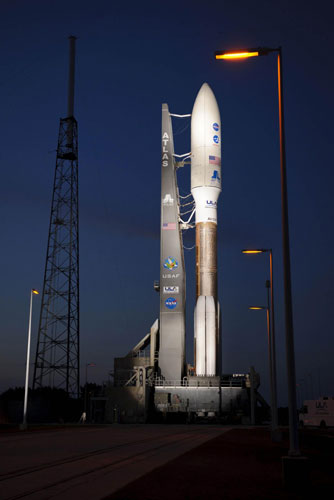Photos
NASA spacecraft begins 5-year trip to Jupiter
Updated: 2011-08-06 11:45
(Agencies)
With the end of the space shuttle program just two weeks ago, Juno's liftoff created more buzz than usual. Several thousand invited guests jammed Kennedy Space Center to watch the Atlas V blast off with Juno from Cape Canaveral Air Force Station next door.
Until Americans start flying into space again from US soil, NASA's science missions will provide the launch excitement. The goal is to send astronauts to an asteroid by 2025 and to Mars in the mid-2030s.
|
|
A few special passengers actually are riding aboard Juno.
Attached to the probe are three little Lego figures specially made of space-grade aluminum. They represent the Italian physicist Galileo, who discovered Jupiter's four biggest moons; the Roman god Jupiter; and his wife Juno, for whom the spacecraft is named.
If all goes well, Juno will go into orbit around Jupiter's poles - a first - on July 4, 2016.
The oblong orbit will bring Juno within 3,100 miles (5,000 kilometers) of the cloudtops and right over the most powerful auroras in the solar system. In fact, that's how the spacecraft got its name - Juno peered through clouds to keep tabs on her husband, Jupiter.
Juno will circle the planet 33 times, each orbit lasting 11 days for a grand total of one year.
By mission's end, "we've essentially dropped a net around the planet with all of our measurements," Bolton said. That's crucial for understanding Jupiter's invisible gravity and magnetic force fields.
Radiation is so intense around Jupiter that Bolton and his team put Juno's most sensitive electronics inside a titanium vault - an armored tank, as he calls it.
Juno's experiments also will attempt to ascertain the abundance of water, and oxygen, in Jupiter's atmosphere, and determine whether the core of the planet is solid or gaseous.
Juno bears nine instruments, including a wide-angle color camera, JunoCam, that will beam back images that the public can turn into photos.
The spacecraft also bears a small Italian-supplied plaque honoring Galileo. It shows his self-portrait, as well as his description of observing Jupiter's moons, in his own handwriting from 1610.
E-paper

My Chinese Valentine
Local businesses are cashing in on a traditional love story involving a cow herder and a goddess
Outdoor success
Lifting the veil
Allure of mystery
Specials

Sowing the seeds of doubt
The presence in China of multinationals such as Monsanto and Pioneer is sparking controversy

Lifting the veil
Beijing's Palace Museum, also known as the Forbidden City, is steeped in history, dreams and tears, which are perfectly reflected in design.

Beer we go
Early numbers not so robust for Beijing's first international beer festival

